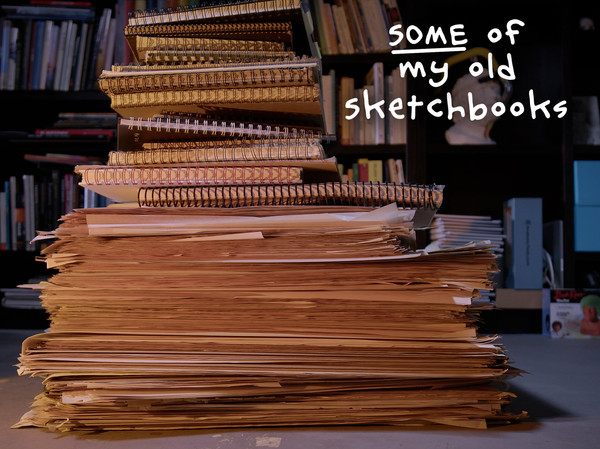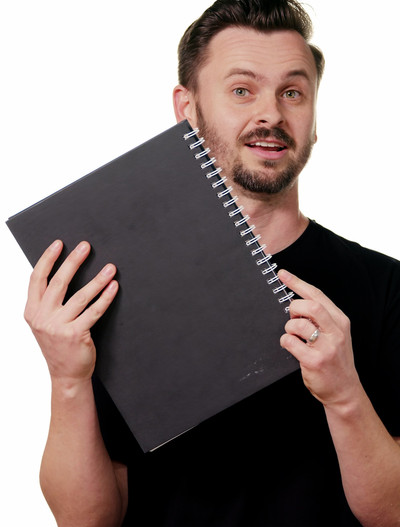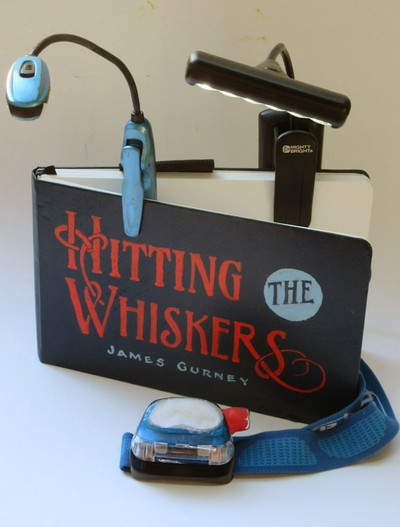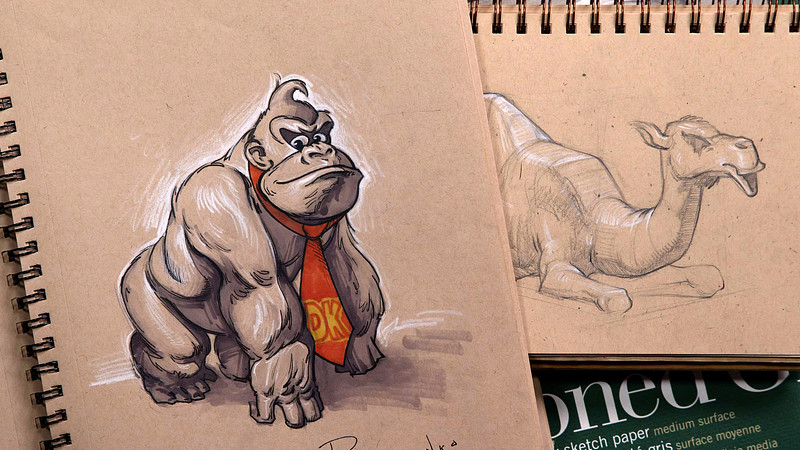Let's take a deep dive into sketchbooks and paper.
If you’re starting your first sketchbook, here's some advice. Do NOT be precious with it. If you think this sketchbook will be filled with beautiful drawings, you're fooling yourself.
This book is just the first of dozens or hundreds that you'll do in your life. Eventually, they will look amazing. Even your silly doodles will be good enough to share with people. But right now, the best thing you can do for yourself is draw a lot. Treating each page as precious can give you anxiety. You’re putting pressure on yourself to make a beautiful drawing, which you don't know how to do yet. It's a recipe for failure, which leads to doubt and fear. Which leads to you drawing less. Which leads to you improving slower and maybe even quitting. It's the spiral of DEATH.
Treat each page as an opportunity to learn something new or get better at something, instead of an opportunity for an impossible goal.
Sketchbooks are portable, which is important because you’re going to be bringing this thing with you everywhere. Yes, you are! Don’t even think about leaving your sketchbook at home. I know you have a busy life so keeping your sketchbook with you will let you draw whenever you get the chance. Like while you’re waiting for the bus or those extra few minutes on your lunch break. And you can just go somewhere and you’ll probably find something interesting to draw. Just you know, try not to stare too much! Sometimes sunglasses can help prevent those awkward moments. Sketching on the go builds your visual library of people, places, and things that you’ll tap into later when you’re drawing from imagination. If you’re sitting somewhere and you’re not inspired by whatever is around you to draw from observation, that’s fine, try to draw from imagination or practice what you learned in a previous lesson. Or just do one of the warm up exercises that I’ll show you.
You can draw whatever you want, as long as you keep drawing. That’s the important thing.
SIZE
Regarding size, there are benefits to working on small and big paper. Like I said, small is more portable. But, get the largest that you can comfortably carry around with you. A larger surface will let you use more of your whole arm to draw. Most of my time at school, we drew in an 18x24 inch pad. It doesn't feel as restricting. I feel more loose, like I’m free to move my hand around. If you want a sketchbook to fit in your pocket, that’s pretty small, but it’s better than nothing. Just watch out so that you don't get into the habit of always drawing super tiny.
Sketchbooks can also be useful because they keep your work chronological, so you can catalog your progress through the years. Going back through old sketchbooks could spark memories of places you’ve been and things you’ve done. Kinda like a diary. But in a cool but nerdy way… and trust me, it feels good to finish a sketchbook. I hope you’ll finish at least one by the end of this course.
BINDING
Personally, I like a sketchbook that I can lie flat on a table or hold comfortably in my lap. I don’t like it when I have to hold the book open with my other hand. That’s why I usually go for the ring or spiral binding. Also, I like a sketchbook that has a thick cover. Thin flimsy covers feel really cheap to me. Which might be a good thing? You decide.
I don’t usually personalize my sketchbooks, but there are a lot of artists that like to decorate the cover. If that sounds fun to you, get one with a clean cover that you can draw on. It’s just a fun thing that could make it feel more like yours. But, if this gives you anxiety to make every drawing good, just get a sketchbook with an ugly cover and start filling it up.
PAPER TYPE
There are a lot of different types of paper, intended for different uses.
- Sketching
- Drawing
- Charcoal
- Pastel
- Mixed Media
- Toned
- Marker
- Bristol
- Printmaking
- Bond
- Vellum
- Tracing
- Watercolor
- Canvas
There’s a lot! I’m going to keep it simple so you don’t get overwhelmed before you even start. Let’s talk about the thing most artists should know for the purpose of drawing, and you can explore more as you progress.
Types of paper you can start experimenting with,
* Some of the items below contain affiliate links
• Sketch
• Drawing
• Toned
• Marker
• Bristol (thicker paper if you're going to spend a longer time on a drawing)
Each type of paper has various combinations of attributes, like texture, weight, color, material, and some other stuff. Let’s start with texture.
PAPER TEXTURE
The ideal paper texture depends on what medium you’re using. The texture is going to show up when you shade with your pencil. Texture isn’t bad. It’s nice when you’re painting, or doing a gritty drawing of an old man with a beard. Or if you just prefer that look when you’re drawing. But if there's too much texture, it can be a distraction, hurt your line quality, or make it harder to add detail.
Since it’s too early for us to be thinking about style and texture, for this course I recommend smooth or slightly textured paper. Most sketchbooks made for ‘sketching’ or ‘drawing’ will work fine. Honestly, even printer paper is good enough for the warm up exercises where we’ll be filling up pages really fast. This way you don’t blow through your more expensive sketchbooks...printer paper is only like a penny per sheet.
PAPER WEIGHT
Paper weight can affect what medium you can use. If you’re using any kind of liquid medium, like paint or markers, you need heavier paper that can handle it without warping or tearing.
Markers also like a thicker paper so they don’t bleed through to the next page. You’ll find out that markers like to bleed to the next page when you apply multiple layers, even if you’re using thicker paper. You might want to put a bleed sheet behind the page you’re working on, so you don’t keep wasting the next sheet in your sketchbook.
I say probably because the "lbs" system that’s used to determine paper weight is very messy and not a good way to compare paper weight across different manufacturers and even different types of paper from the same manufacturer. An “80 lb paper” means that a stack of 500 sheets of that uncut paper weighs 80 lbs. The problem is that there is no standard to how big the uncut sheets are. And obviously, a stack of 24x36 inch paper is going to weigh more than a stack of 20x30 inch paper. So, you can have two different sketchbooks, both labeled 80 lbs, but one clearly has thicker paper than the other. The GSM method is much less confusing. 130 grams per square meter, simply means that 1 sheet the size of 1 meter by 1 meter, weighs 130 grams. That’s it.
For dry mediums like graphite, charcoal, or colored pencils, you can use thinner paper for your sketchbooks. The only reason I would consider going higher than 130 GSM for dry mediums, is if I’m doing professional work. A commission or a gallery piece.. Something that I’m going to frame and hang on a wall. And that’s just because thicker paper is more durable. It feels more professional and expensive. But in that situation, I’m not using a sketchbook. I’ll get a pad of nicer paper or some individual sheets.
If you’ll be using any wet mediums, like markers or watercolor, I recommend going higher. At least 130 GSM for markers and ink. And more like 300-600 GSM for heavier water applications, like watercolor or staining with charcoal.
PAPER ARCHIVABILITY
Archivability is mainly determined by what the paper is made of. You’ll see a lot of paper labeled “acid-free” or “archival”, and then you’ll see something like “newsprint” at a fraction of the cost. You have to ask yourself how long you want your drawings to last. Drawings on non archival paper like newsprint will yellow and wrinkle within a couple weeks or even days if you leave it in a hot car. If you’re careful and you keep newsprint out of heat, light, and moisture, it’ll be fine for many many years, but it’ll still slowly become yellow.
You probably don’t want to sell your newsprint drawings to serious collectors because it’ll look pretty crappy within the buyer’s lifetime and you’ll have some awkward explaining to do. But if you’re on a really tight budget and just want an affordable way to knock out a bunch of practice drawings that you don’t care about selling, newsprint paper works really well. Mainly if you’re using charcoal pencils, like I do in my figure and anatomy courses. Make sure to look for the “smooth” newsprint. Rough newsprint is heavily textured and a little harder to work with. Most artists that I know, prefer the smooth newsprint.
So, if you want paper that will last a long time, make sure it’s “acid free”.
Another thing to consider for archivability is what the paper is made of. Most paper is made of wood pulp, which is fine. But premium papers like the Strathmore 500 series is made of cotton. And cotton is known to be more archival. Many artists prefer to work on it because they like the way it absorbs the material and it's more durable, so you can erase more aggressively.
TONED PAPER
I love toned paper! There’s a lot of benefits to it.
1. It’s fun
2. You can use a white charcoal pencil on it, which makes those highlights pop.
3. It can save time because you don't have to shade up to that mid value. It’s already there.
4. It can help some people cope with the blank page fears because it doesn’t feel like a blank page.
5. It’s fun (even more fun!)
6. And some toned papers have a fibrous / woodchip texture
Strathmore describes their toned paper to be “100% recycled, contain 30% post-consumer fiber, and also contain kraft and bark fiber inclusions which adds visual interest”. It adds a visual texture. The paper is totally smooth, it doesn't affect the way the pencil goes down on the paper.
I remember that when I was in school, I loved sketching on recycled toned paper because it made my drawings look more interesting. The drawings weren’t actually better, but it made me feel better about my drawings. Which is kinda nice!
PERSONAL TASTE
So, now you know all this stuff about paper, but in the end, it comes down to personal taste. You might get a premium quality 100% cotton paper, but not like it as much as a cheaper option. Test some and see what you like. Look for how the texture feels. Do you like a super smooth paper or is that too slippery? More texture will let you feel the paper more but it could also smudge more. Do you like that? Does your eraser work well with it? How much can you erase? These are the questions you should be asking yourself.
Ok, now that you’ve got your sketchbook, let’s get drawing. If you need someone to show you the fundamentals so you can hit the ground running, join my Drawing Basics course. The premium course includes extended lessons, project demonstrations, and critique videos.
I hope you enjoy messing around in your sketchbook. And if you enjoy the lessons, please tell your friends, tell your classmates, tell your teachers. Your word of mouth really helps to make the course better and fund the free videos we make. Thanks for stopping by, I’ll see you next time!




















